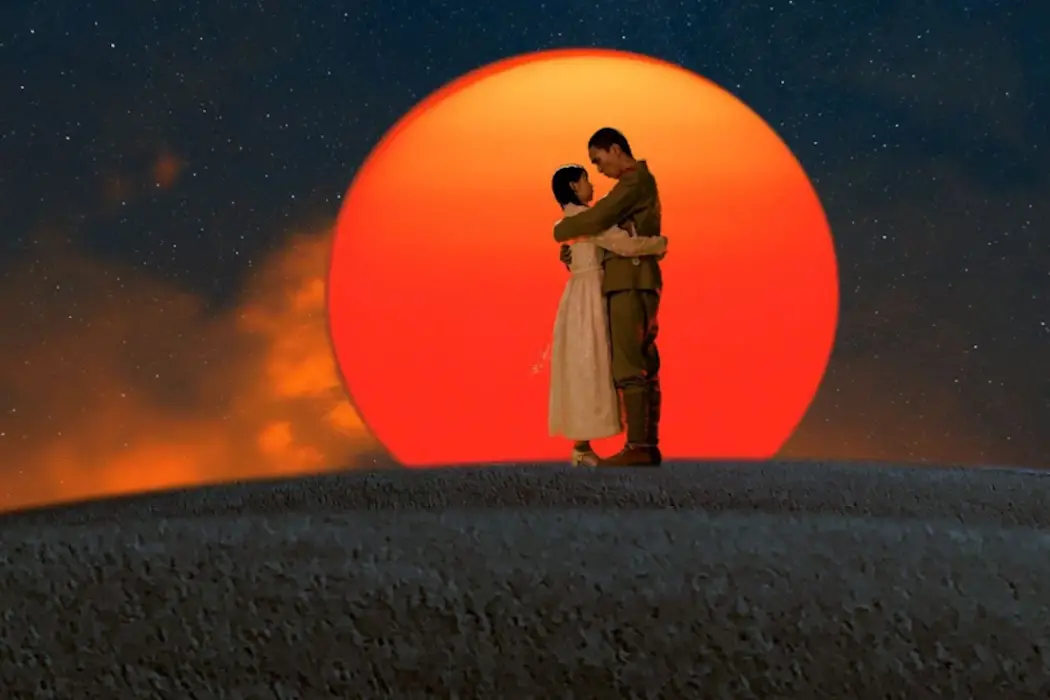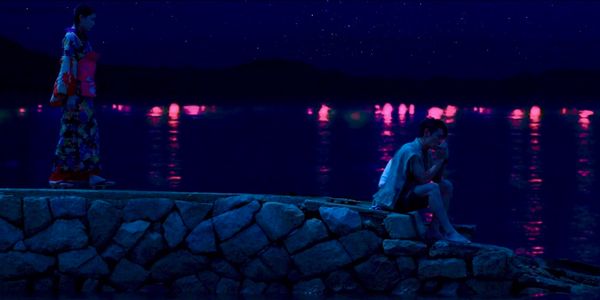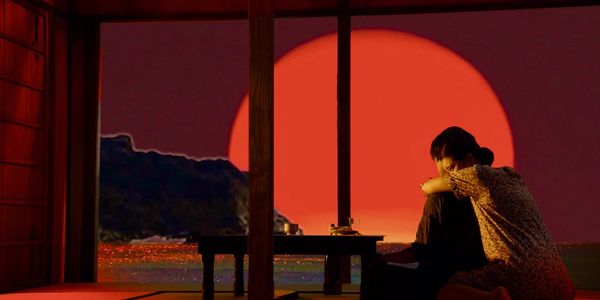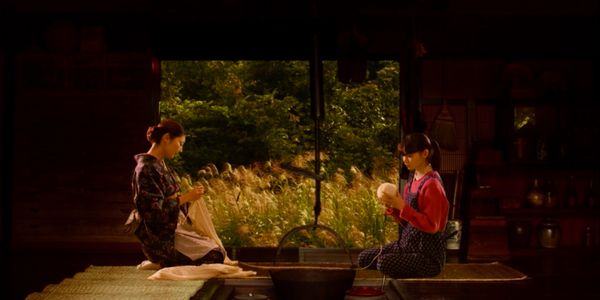LABYRINTH OF CINEMA: Exploring the Difference Between Real and Reel

Soham Gadre is a writer/filmmaker in the Washington D.C. area.…
Political cinema – especially that which is produced through mainstream industries – is constantly in a state of crisis between its endeavors as entertainment and a reflection of real histories and tragedies. Perhaps this complicated and at times mind-warping paradox of contradictory places that movies find themselves is what Nobuhiko Obayashi is referring to when he considers the “labyrinth” in his final film, Labyrinth of Cinema. It’s a conundrum that is explored throughout the entire movie, in a furious and unrelentingly unstructured style that may be off-putting for some, but undeniably eye-catching for everyone.

Nobuhiko Obayashi’s passing this year and the 75th anniversary of the Hiroshima bombing by the American army make Labyrinth of Cinema a particularly melancholy viewing experience that is both drenched in the sadness of war and death while eliciting a celebratory retrospective and examination of the art that Obayashi dedicated his life to. Hiroshima was a world-shaking event which, as film critic Ignatiy Vishnevetsky pointed out, we are still currently living in the paranoid aftermath of. He goes onto say that David Lynch’s Twin Peaks: The Return is the only modern American artwork that understands this feeling. Japan, necessarily, has Hiroshima as a textual and sub-textual presence in many different movies, from the Godzilla series to, more broadly subgenres like kaiju films and mecha-anime.
A Tour of Wonders and Melancholy
Obayashi’s incorporation of Hiroshima is in the context of its effect as a tragedy on the cinema of Japan, namely in the fictional depiction of suffering on screen. The suffering is truth, but the depiction of it in fictional cinema is a lie. A major theme of Labyrinth of Cinema is the idea of cinema as a lie. Godard of course famously said that ‘every cut is a lie’ and Haneke proclaimed cinema as ‘24 lies per second’. These definitive statements are examined by Obayashi in the context of movies as fabrication of reality but maintaining a conscious understanding that this fabrication is based on a real truth – thus, we get the movie’s most oft-spouted phrase: “there is truth in the lie”.
The movie has a prologue of sorts, with a narrator/tour-guide named Fanta G (Yukihiro Takahashi) inside of a space-ship speaking about the history and importance of cinema as an art to the human race. He and his ship descend on modern-day Japan and introduce us to a movie theater where three boys – a young romantic named Mario (Takuro Atsuki), a wannabe yakuza named Shigeru (Yoshihiko Hosoda), and a history nerd named Hosuke (Takahito Hosoyamada) enter a screening for a new immersive film experience on the history of Japan. The experience turns literally immersive as they are warped into the cinema screen itself and play all of the central characters through nearly 50 years of Japanese history beginning with the Edo period and ending with the conclusion of the atom bomb drop on Hiroshima.

Very much in keeping with Obayashi’s genre-warping style – which mixes worlds and dimensions together, marries romance to terror, war to comedy, and action to science-fiction – Labyrinth of Cinema tries to say everything and be everything in its three-hour run-time, something possibly attributed to Obayashi’s acknowledgment of his declining health and possibility that this would be his final work. We are whisked on a roller-coaster tour of samurai sword-fighting, reenactments of historical events, and encounters with legendary filmmakers like John Ford and Yasujiro Ozu, a romantic angle between Mario and a girl named Noriko (Rei Yoshida), and narrated history lessons from our wacky tour guide Fanta G of Japan’s slowly evolving imperial influence following the fall of the last shogunate. All of this is deliriously splashed with an entire rainbow of color and wildly edited in a cocaine-high frenzy.
Truth in the Lie, Tragedy in the Entertainment
Probably the most noticeable trait of the film is that it is shot almost entirely in front of blue-screens and green-screens and has a deliberately obvious look of a fake staged student film with comically fraudulent visual effects. While we have made it a cultural tradition here in Hollywood-dominated American cinema to condescend low-budget production values, as is evident for cult ‘bad movies’ like Birdemic, what makes Labyrinth of Cinema’s fakery special is that it is connatural to the film’s thesis statement.
The visual template used in the movie continually distorts reality, making it obvious that what we are watching is people play-acting in fake scenarios, with fake props, and a fake background. There is a constant recognition of the fraud of cinema and thereby a confrontation of modern cinema’s need to depict atrocity and tragedy through “reality”. It completely rejects the thesis of films like Saving Private Ryan or more recently, 1917, which try to use technique and million-dollar effects and sets to create as realistic mimicry of human suffering for our entertainment as possible. Instead, the acknowledgment – a quite radical one – is that there is truth in the lie of cinema, but the lie is what is shown on screen and it must distinguish itself from its representative truth. In making its reenactments look as fake as possible, the movie amplifies its acknowledgment of reality by visually distancing the fictional renditions as far away from ‘real’ as possible.

Instead, the suffering and tragedy of Japan and the linearity of its history are metaphorically depicted through the character Noriko, who is Mario’s love interest. She is, throughout the movie, continually lost and found, trapped and saved, killed off and revived again, representing the rise and fall of eras in Japanese history and the tumultuous peril of its people. We are also taken on a whirlwind of Japan’s cinema, with reenactments of interviews with Yasujiro Ozu and Sadao Yamanaka, both of whom served in the Imperial Army and the latter who died during service.
Conclusion
Labyrinth of Cinema is a true epic, which uses its three-hour runtime as a fully immersive playground of cinematic experiments. It can be exhausting and overstuffed, but it is the work of someone who truly understands the meaning that cinema played in his life. It’s a definitive final statement by Obayashi, and a confrontation of our ideas of what movies are (a lie), what they represent (a truth), and how we distinguish between the two.
How does Labyrinth of Cinema compare to the previous films of Nobuhiko Obayashi? Let us know in the comments below!
Labyrinth of Cinema played at the Japan Cuts Film Festival Online on July 30th, 2020.
Does content like this matter to you?
Become a Member and support film journalism. Unlock access to all of Film Inquiry`s great articles. Join a community of like-minded readers who are passionate about cinema - get access to our private members Network, give back to independent filmmakers, and more.
Soham Gadre is a writer/filmmaker in the Washington D.C. area. He has written for Hyperallergic, MUBI Notebook, Popula, Vague Visages, and Bustle among others. He also works full-time for an environmental non-profit and is a screener for the Environmental Film Festival. Outside of film, he is a Chicago Bulls fan and frequenter of gastropubs.













